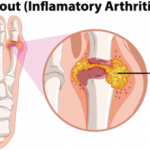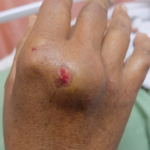Using 2007–2016 data from NHANES, a nationally representative survey of American men and women, Chen-Xu et al. set out to estimate the current prevalence rates and decadal trends of gout and hyperuricemia in the U.S.
Search results for: gout

The ACR’s & EULAR’s Gout Guidelines Include Treatment Approaches
SNOWMASS VILLAGE, COLO.—The 2019 ACR Winter Rheumatology Symposium featured a session on gout. Despite a good understanding of its pathogenesis and the many effective therapies to treat it, gout remains a major public health problem in the U.S. Ann K. Rosenthal, MD, Will and Cava Ross professor of medicine and chief of the Division of…

Gout & Sexual Function
Pain, physical disability and joint deformity have been linked to sexual dysfunction. New research suggests gout may also significantly affect relationships and intimacy. The study found the physical effects of gout on intimacy, such as joint pain, were the top-ranked concern for gout patients…

Research Is Advancing Our Understanding of Gout & Hyperuricemia
CHICAGO—The Gout and Hyperuricemia scientific session at the 2018 ACR/ARHP Annual Meeting opened with a talk by Tony R. Merriman, PhD, a research professor at the University of Otago, New Zealand. His talk focused on molecular epidemiology, with an emphasis on the interactions between genes and environmental exposures, and their contributions to gout. Dr. Merriman…

New Study: Does Urate-Lowering Therapy Reduce Gout-Patient Mortality?
Results of a recent study in Arthritis & Rheumatology fail to clarify whether urate-lowering therapies may potentially reduce mortality risk in patients with gout.1 The study also underscores the fact that many physicians are not following the ACR guideline to help their patients achieve target serum urate levels. Partly because of this, it remains unclear…

FDA Issues Boxed Warning for Febuxostat & Approves Colchicine for Gout Flare
The FDA has issued a boxed warning for febuxostat after a safety study found an increased risk of heart-related and other death in RA patients…
Coding Corner Question: Use Level 3 or 4 for RA/Gout Patient?
A 60-year-old man returns for a follow-up related to his diagnoses of rheumatoid arthritis and chronic gout of his right ankle and foot, without tophi. He reports the gout flares have subsided in his ankle. He takes 450 mg of allopurinol daily. He has rheumatoid factor-positive rheumatoid arthritis, which previously affected multiple sites, without organ…
Coding Corner Answer: Use Level 3 or 4 for RA/Gout Patient?
Take the challenge. CPT: 20611-LT, J7325-EJ ICD-10: M17.12, E66.01, Z68.41 CPT: 99213 ICD-10: M1a.0710, M05.79 History—The history of present illness was extended. The review of systems was extended, and two past family social history elements were documented. This makes the history level detailed. Examination—Five systems were examined. This makes the exam level detailed. Medical decision…

Canakinumab Reduces Risk for Gout Flares, But Not Serum Uric Acid Levels
An exploratory analysis of a canakinumab clinical trial has shown the interleukin 1β inhibitor may significantly reduce patients’ risk for gout flares. During the study, patients using canakinumab experienced this decreased risk, but the treatment did not change serum uric acid levels…

Older Gout Patients More Likely to Develop Hearing Impairment
Previous research has established that gout and hearing loss have shared risk factors. Now, a recent study found gout itself is associated with an increased risk of hearing loss in adults 65 years and older…
- « Previous Page
- 1
- …
- 7
- 8
- 9
- 10
- 11
- …
- 58
- Next Page »